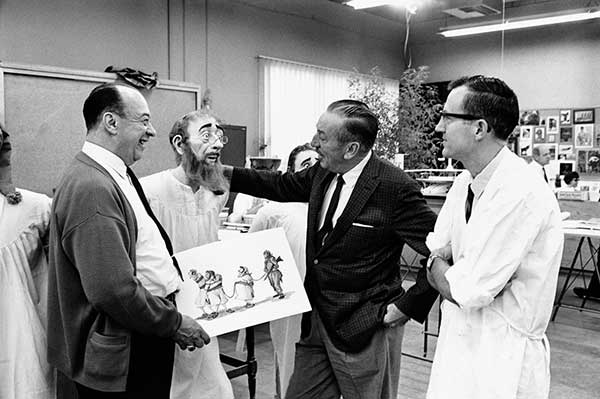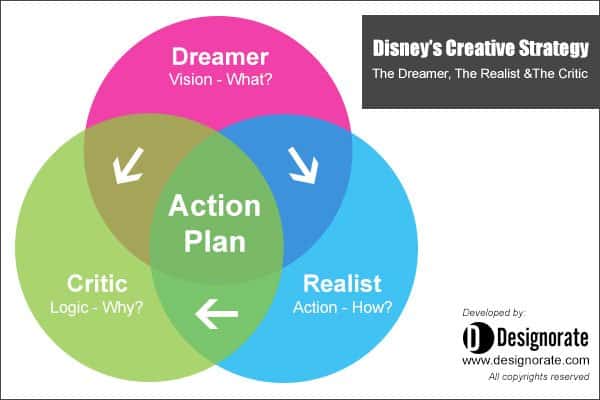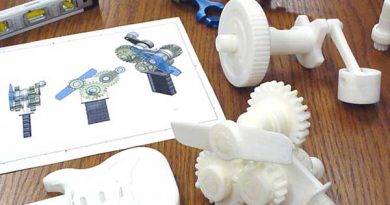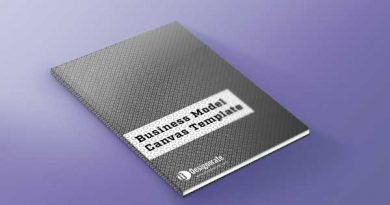Disney’s Creative Strategy: The Dreamer, The Realist and The Critic
Recently, we introduced a number of methods and tools to fuel innovation and creativity inside organizations through creative thinking and brainstorming such as Lego Serious Play, De Bono Six Thinking Hats and Reversed Brainstorming. Disney’s Creative Strategy is another tool for creative thinking and was inspired by Walt Disney.
He was talented in discovering creative ideas and converting them into reality. Based on a close associate, he used to say “There were actually three different Walts: the dreamer, the realist, and the spoiler. You never knew which one was coming to the meeting.”
Walt Disney’s strategy was highlighted and modeled later in 1994 by NLP expert Robert Dilts. He defined the technique as Disney’s method for turning his dream into reality. In this method, the group of people use a specific thinking flow which builds parallel thinking that can be used to generate, evaluate, critique ideas and solve problems.
Although the method was not fully developed by Walt Disney, it bridges the gap between imagination and reality. The creative process unlocks the mind’s capabilities to dream and form unexpected ideas and solutions for existing problems. However, these solutions may not be applicable in reality and may not can be applied as strategic plan. Therefore, one if the advantages of Disney’s creative strategy method is balancing between both dream and reality in order to build a viable layout.

Robert Dilts describes Disney’s ability to explore creativity: “Walt Disney’s ability to connect his innovative creativity with successful business strategy and popular appeal certainly qualifies him as a genius in the field of entertainment. In a way, Disney’s chosen medium of expression, the animated film, characterizes the fundamental process of all genius: the ability to take something that exists in the imagination only and forge it into a physical existence that directly influences the experience of others in a positive way.”
Preparing for Disney’s Creative Strategy
In order to prepare the team for Disney’s Creative Strategy; four parts of the room are set for each thinking method. The first part is for dreaming and imagination, the second part is for realists and/or planning, the third part is for critics and the fourth part is for getting the mind outside the thinking flow.
The idea of setting a thinking place for each stage in the method is to prepare the team mind to switch thinking modes from one to another. The place can be a room, open space office or an outdoor garden.
The team gathers with a target to achieve, this target can be a dream to turn into reality, design to visualize, problem to solve or process to improve. However, the history of the Disney’s method qualifies it to fit with creative brainstorming to help turn dreams into applicable projects.
Disney Creative Strategy stages
The strategy is based on three main stages; the dreamer, the realist and the critic. Each stage represent a style of thinking and it should be applied in the same sequence as below:
The dreamer
Usually, any creative idea starts with a dream full of passion and enthusiasm. In ordinary meetings, this dreaming style is halted by reality and does not have the space to go further on. Discussed in details. in this Disney Creative Strategy, the first stage allows the team to share their dream without no restrictions or criticism. This helps to build a pool of creative ideas. Some of these ideas are viable and others are not. Determining the viable creative concepts comes later as a result of the second and third thinking styles.
The dreamer asked questions that help describing ideas and though such as the following:
- What do we want?
- What is the solution?
- How do we imagine the solution?
- What are the benefits of applying this solution?
The realist
Now, subsequently, follows the realist style. The team switches the place and mode to think in a more logical planning style. Based on the first stage, the attendees pretend that the dream is possible and start putting plans to achieve it. The plans aims to turn the imaginary ideas into a manageable action plan. During this stage all the thoughts should be constructive and target turning the idea into a real plan. This stage includes questions such as the following:
- How can we apply this idea in reality?
- What is the action plan to apply the idea?
- What is the timeline to apply this idea?
- How to evaluate the idea?
The Critic
After having an action plan to turn the idea into reality, the critic thinking mode tends to discover the barriers of applying the idea and how to overcome it. In this session, the team provides a constructive critique for the idea in order to find the weak points and solve it in the final solution. In this stage, the team asks questions as following:
- What could be wrong with the idea?
- What is missing?
- Why cannot we apply it?
- What are the weaknesses in the plan?
Conclusion
As a result of the three main stages above in Disney’s Creative Strategy, the team reaches a solid creative idea with an action plan to apply it. The first stage focused on the creative aspect and sharing creative ideas and solutions. The second stage focused on reality and how to turn the idea into an action plan and finally the third stage aims to identify the weakness in the idea and overcome it in the final plan.
While other creative thinking methods such as Six Thinking Hats do not restrict with a specific sequence for the steps, Disney’s Creative Strategy needs following the steps as stated above.
[/ms-protect-content]








You mention the fourth part of the room is for getting the mind outside the thinking flow. Can you provide more detail on this fourth part and questions to ask?
Hi Sarah, I am sorry for the late reply. The fourth side of the room represents the final conclusion to be addressed. The attendees don’t use the method flow anymore as they go through the three steps. At this part, attendees make a decision about their ideas based on the previous steps.
I found this article very interesting. I teach new business owners and have learned some interesting creative processes to teach from this article.
Thanks!